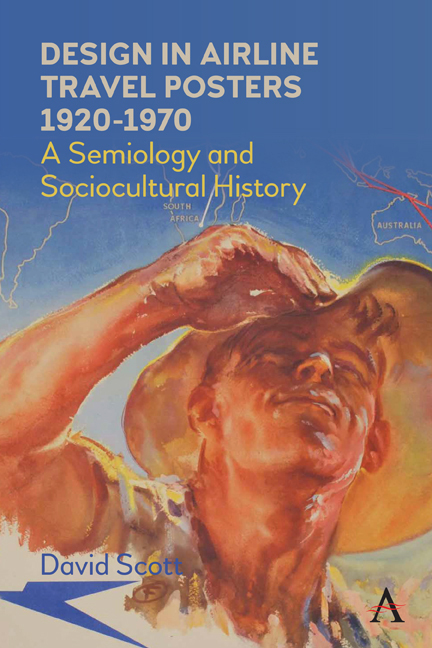Book contents
- Frontmatter
- Dedication
- Contents
- List of Figures
- Introduction
- 1 Fact and Fantasy: Reading and Misreading the Poster Image
- 2 People, Places and Planes: Destinations and Itineraries
- 3 Looking Out and Looking Up: Framing Devices and Indexical Signs
- 4 Indigenous Peoples
- 5 Glamour and Sex Appeal: Designing Desire
- Conclusion: The Decline of the Airline Travel Poster
- References
- Index
1 - Fact and Fantasy: Reading and Misreading the Poster Image
Published online by Cambridge University Press: 09 February 2021
- Frontmatter
- Dedication
- Contents
- List of Figures
- Introduction
- 1 Fact and Fantasy: Reading and Misreading the Poster Image
- 2 People, Places and Planes: Destinations and Itineraries
- 3 Looking Out and Looking Up: Framing Devices and Indexical Signs
- 4 Indigenous Peoples
- 5 Glamour and Sex Appeal: Designing Desire
- Conclusion: The Decline of the Airline Travel Poster
- References
- Index
Summary
This chapter centres on the airline poster image's double status: objective information and subjective fantasy or desire. The richness of airline posters in the early modern age of graphic reproduction (1920–50, with 1950–70 marking a transition period) is invariably a function of this double agenda. For the poster's aim is to portray an image that elicits from the viewer intense identification through both its formal structure and its ostensible content. In poster art, visual strategies are therefore developed to maximize viewer identification on both a rational and a fantasy level. Sometimes it is the appeal of the graphic image that fulfils desire while the textual component supplies the objective information. At other times, the textual message itself becomes as much a seductive agent as the image – as in those memorable and enticing slogans developed by many airline companies from the 1940s. Alternatively, in the most successful posters, it is the indissoluble combination of the two, text and image, that ensnares or enchants the viewer/reader who is invited to bring both textual and visual understanding to bear on the unravelling of the poster message. In this way the most persuasive posters mobilize a rhetoric of image-text that the very act of apprehension persuades the receiver to enter into, inviting them to enjoy the poster's creation of meaning as an enticing textual/visual game (see Scott, 2010).
It is the desire or fantasy aspect of the image that normally comes across as strongest in the travel poster. But there is always a risk attached to it. Whereas the objective, factual aspect of the poster information can be verified and is rarely problematic, the desire element is very much open to interpretation. The poster designer of course aims to control that interpretation (see Scott, 2010) so that it is correctly grasped. If he or she fails, the outcome can be disastrous, as in those posters in which the real/informational element of the poster fails to temper and control the fantasy element. A striking example of this is provided by one in a series of Australian Airlines posters of 1990, examined below, in which the real destination of the airline, though visually present, is upstaged or falsified by an attendant erotic scenario that was so misread by its intended audience that the poster had to be quickly withdrawn.
- Type
- Chapter
- Information
- Design in Airline Travel Posters 1920–1970A Semiology and Sociocultural History, pp. 7 - 24Publisher: Anthem PressPrint publication year: 2021



